USMC looks to unmanned future
‘Swarms’ of UAS will take over from manned aircraft in future operations the USMC Warfighting Laboratory is predicting and the change will need more precise control of airspace and networks.
This increase will be a stark comparison to recent trends, which have seen the number of manned aircraft being used reduced, resulting in one aircraft being used per collateral mission during Operation Iraqi Freedom and Operation Enduring Freedom.
It is envisaged that an ‘explosion’ of small UAS is the key to future mission success for the USMC, but this must be based on improving warfighting capability and not just be a ‘love-affair with technology’. In 2000 there were 50 unmanned aircraft in the USMC, and now there are some 8,000.
‘In ten years we are going to see an aircraft carrier with nothing on it but unmanned systems,’ Bill Powers of the USMC Warfighting Laboratory told the Defence IQ Air Weapons Integration conference in London on 25th May.
‘Budget is going to drive this more than anything,’ he continued, pointing out that a carrier-based aeroplane is the most expensive way ‘by far’ to aerially deliver a weapon.
‘You can buy squadrons of armed, ISR UAS for the price of one F-35B’, he added
Despite armed aerial platforms now being able to ‘plug and play’, which is deemed advantageous to the warfighter, Powers emphasised that on the future battlefield the military needs to rethink the way it plugs and unplugs into the net.
‘The amount of information available today is pretty much overwhelming. One solution I think is to be able to unplug from that network,’ commented Powers.
‘There are times that there is so much information there that we don’t care about.’
The Laboratory wants armed UAS to be able to ‘unplug’ from the big network, and instead link to its own local area network, tell it what to do for the day, and it will do it. Powers said he wants: ‘What we need when we need it, not everything all the time’.
In the past rotary wing and fixed wing aircraft have separated their airspace by altitude, but now UAVs such as the Tracker, Reaper and Shadow, will all fly at same altitude as the manned aircraft, and airspace needs to be controlled differently. C2 is therefore paramount to the USMC in these situations.
Alongside platform numbers, the impact and precision of targets has also changed, with lots of targets being taken out in each mission.
‘Now we can pretty much go out with one aeroplane, one or two weapons, and you’re pretty much sure you can take out the targets. We have far more systems in the air, and we are getting more and more systems that are plugging into the net,’ said Powers
‘There are so many sensors available in theatre now; we are overwhelmed with information available through the net’.
More from Uncrewed Vehicles
-
![What's next for the Pentagon after the Replicator programme?]()
What's next for the Pentagon after the Replicator programme?
Although the Replicator initiative has made several accomplishments, there are still multiple gaps to plug across the US Department of Defense (DoD) and its services.
-
![Cummings Aerospace showcases Hellhound loitering munition designed for US Army’s LASSO programme (video)]()
Cummings Aerospace showcases Hellhound loitering munition designed for US Army’s LASSO programme (video)
Cummings Aerospace presented its turbojet-powered Hellhound loitering munition at SOF Week 2025, offering a man-portable solution aligned with the US Army’s LASSO requirements.
-
![SOF Week 2025: PDW unveils attritable FPV drone for SOF operations at scale]()
SOF Week 2025: PDW unveils attritable FPV drone for SOF operations at scale
PDW has revealed its Attritable Multirotor First Person View drone at SOF Week 2025, offering special operations forces a low-cost, rapidly deployable platform for strike and ISR missions, inspired by battlefield lessons from Ukraine.
-
![SOF Week 2025: Teledyne FLIR white paper provides guidance on reusable loitering munitions]()
SOF Week 2025: Teledyne FLIR white paper provides guidance on reusable loitering munitions
Teledyne FLIR is highlighting the emerging requirements for 'recoverable and re-usable' loitering munitions across the contemporary operating environment during this week’s SOF Week conference in Tampa, Florida.
-
![SOF Week 2025: Kraken Technology group debuts K3 Scout USV in North America]()
SOF Week 2025: Kraken Technology group debuts K3 Scout USV in North America
High-performance maritime industry player Kraken Technology Group, based in the UK, has used the SOF Week conference in Tampa, Florida this week to debut its K3 Scout uncrewed surface vessel (USV) to the North American market.
-
![Palladyne AI and Red Cat to demonstrate capabilities for autonomous drone swarms to the US military]()
Palladyne AI and Red Cat to demonstrate capabilities for autonomous drone swarms to the US military
Red Cat and Palladyne AI recently conducted a cross-platform collaborative flight involving three diverse heterogeneous drones.

























